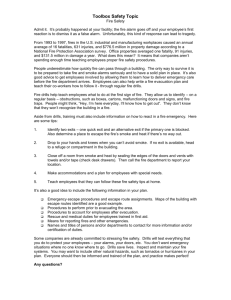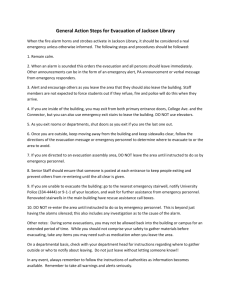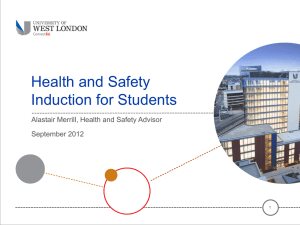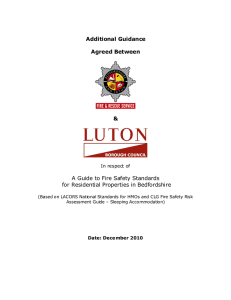Fire Safety - University of Bristol
advertisement
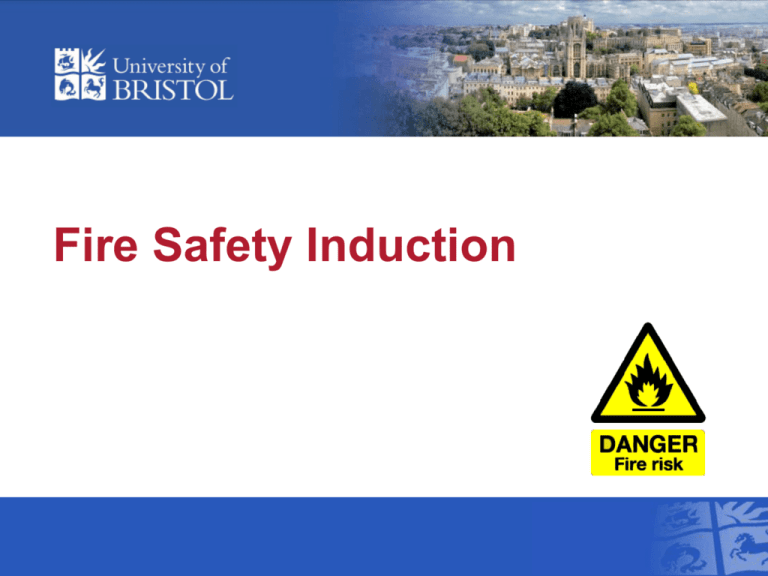
Fire Safety Induction Overview We will look at • • • • • • Legal requirements Understanding fire Fire hazards and risks Fire prevention and control Fire extinguisher safety Fire procedures Legal Requirements Regulatory Reform (Fire Safety) Order 2005 requires that; • Fire risks are identified and controlled • A Fire Risk Assessment is completed and reviewed regularly or if work areas change • Findings are implemented, so far as is reasonably practicable Understanding Fire Fire is real • In 2 ½ years from Jan 2007 – June 2009 19 fires occurred in the University of Bristol • 17 were small and contained • 2 were serious… School of Chemistry, 2007 Faculty of Engineering Queen’s Building, 2008 Understanding Fire Fire needs 3 things to exist • Fuel • Oxygen • Heat “The Fire Triangle” Understanding Fire Fuel • • • • • • • Chemicals - acetone, ether, methanol, etc Gases - hydrogen, natural gas Plastics - PCs, cable insulation, research equipment Paper and cardboard - packaging Wood - desks, benches Fabrics - chairs, blinds, clothing You… Understanding Fire Oxygen • A natural component of air @ 21% • Enriched atmospheres, > 21% oxygen labs, oxygen storage • Situations where oxygen / air is more difficult to control: Outdoors Automatic ventilation systems Open doors or windows Understanding Fire Heat (Ignition Source) • • • • • • Heating appliances Research and computer equipment Other electrical equipment Smoking materials Contractor’s equipment Arson Understanding Fire Hazards and risks of fire • Smoke & fumes Breathing difficulties, asphyxiation, poisoning • Heat & flames - up to 1250°C Burns • Building debris Impact injuries, burns • Injury while escaping fire Trips, falls, trampling Fire Prevention • • • • Be fire safety aware Control ignition sources Prevent any accumulation of fuels Only use electrical equipment that is PAT tested • Abide by the University no smoking policy Fire Prevention • • • • • Do not block fire exits, call points or extinguishers Do not wedge fire doors open Ensure good housekeeping Maintain effective security Report any bad practice or risks immediately to your line manager Fire Prevention Fire alarm testing • Is a legal requirement • Alarm will sound for 15 seconds (add details of your departmental or building testing regime) • No need to take action during a test, however if the alarm sounds for greater than 15 seconds, or at any other time than the arranged testing, you must treat as genuine alarm and immediately evacuate Fire Procedure - Finding a Fire If you discover a fire • Shout ‘FIRE’. • Raise the alarm by breaking the glass on a RED fire alarm call point. • Call Security on 112233. Security officers / the Security control will call 999 on your behalf but you can always call the Brigade directly if you know there is a fire. • Do not return to your desk/work area to collect personal belongings • Leave the building by the nearest available fire escape route. • Go to the assembly area and await instruction. Fire Extinguisher Types Water Paper, wood, etc. Not electrical, liquids or gases Foam Solids & liquids Not electrical or gases Powder Solids, liquids, gases & electrical CO2 Electrical, safe on most small fires Fire Procedure - Evacuation On hearing the alarm • Call Security on 112233 to advise of the fire alarm – do not assume someone else has done it. • Leave the building by the nearest available fire escape route. • DO NOT delay your escape but if you can turn off equipment/close doors and windows as you leave then do so. • Go to the assembly area and await instruction Fire Procedure - Evacuation • Do not delay to collect belongings • Do not use the lifts • If smoke is present then keep low to the floor to add your escape • If necessary check that internal doors are cool with the back of your hand before opening them Fire Procedure - Evacuation Electrically locked security doors • Lock will auto release when the alarm activates, just push the door open • Break glass release button only if door does not unlock • If you break glass notify the Porters or the Buildings Manager for replacement Fire Procedure - Evacuation People with disabilities • Need to be assisted by volunteers or nominated personnel, detail will be available in their Personal Emergency Evacuation Plans (PEEP’s) • For special events ensure that disabled persons have been taken into account and an evacuation plan is in place • (Add details of Departmental Evacuation Plan) Fire Procedure - Evacuation On exiting the building • Add diagram if possible of exit • Report to designated routes for assembly point promptly • Don’t block any Emergency Services department or form building route to the building Fire Procedure - Evacuation On exiting the building • • • • Report any missing colleagues to your Fire Warden Report any disabled persons left at Refuge Points Remain at assembly point until advised otherwise Do not wander off as it may be assumed that you are trapped in the building On Your Return to Your Workplace Today Ensure that you know; • The escape routes • Final exit doors and how to open them • Location and types of fire fighting equipment • Locations of call points • Any specific fire procedures including the assembly points • Who your fire wardens are • Who to report to with any defects or bad practices Examples of defects to report • • • • • • Covered smoke detectors Fire doors damaged or not closing properly Broken/damaged lighting, especially emergency lighting Missing or damaged fire extinguishers Service riser covers open. Accumulation of rubbish and clutter excessive paper in offices etc. • Obstructed corridors. Summary • • • • • • • • • As a member of staff at the University you have a responsibility for fire safety. Make sure you know: What the fire alarm sound like in your building The Escape routes within your building If you discover a fire, how to raise the alarm What to do if you hear the fire alarm Who to call if a fire starts How to open final exit doors Why is it important to go to the assembly area? Why fire doors should remain closed at all times? Why are fire extinguishers provided? Thank You! Any Questions?


